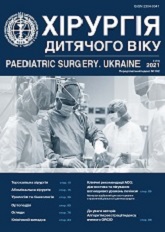Halo-gravity traction in the treatment of complex spinal deformities in children with respiratory dysfunctions
DOI:
https://doi.org/10.15574/PS.2021.72.10Keywords:
spinal deformity, respiratory dysfunctions, halo-gravity tractionAbstract
HGT is a safe technique as the world literature describes complications in the form of loosening of the pins or superficial infections of the skin around the pins, which are not significant and do not pose a threat to the patient’s life.
Purpose – to improve the results of the ventilation function of the lungs in patients with complex spinal deformities through the preliminary use of halo gravity traction and to introduce an effective and safe method for the treatment of complex spinal deformities in children with respiratory dysfunctions.
Materials and methods. 64 children with complex spinal deformities (>100°) were treated in the orthopedic and traumatology department of the Okhmatdet NSPU using halo gravity traction during the period from 2003 until 2018. Of these, 38 are boys and 26 are girls. The average age of the patients was 11.6 years. The average Risser score was 3.8 (P>0.01).
Results. According to the data of spirography performed, 46% of patients had moderate ventilation disorders and 54% – severe ventilation disorders (FVC<60% – grade 3 and 4 of ventilation failure). Mixed type disorders were recorded in 83% of patients, and restrictive type disorders in 17% (8/48) of children. After HGT, there was an improvement in pulmonary function indicators: an increase in FVC from 63.19% to 71.77% and FEV1 from 54.71% to 65.46%, Tiffeneau-Pinelli index – from 74.59% to 85.33%. Compared with the initial level of indicators, the improvement in FVC was 13.6% after HGT and 14.6% in dynamics during the year, and FEV1 – 19.6% and 21.6%, respectively. The results obtained indicate a significant improvement in the ventilation function of the lungs, especially due to the degree of FEV1 increase, which correlates with the degree of improvement in performance, mortality and life prognosis.
Conclusions. The use of HGT makes it possible to improve the results of the final correction of spinal deformity, which in turn significantly improves the ventilation function of the lungs, which in turn helps to reduce the risks of mortality due to pulmonary insufficiency in adulthood. The choice of the appropriate methods of surgical correction for complex deformity of the spine is a prerequisite for successful treatment and the achievement of three-dimensional correction of the spine to maximally approximate its parameters to the physiological norm. The indication for halo gravity traction is a rigid scoliotic deformity of the spine with a deformity angle (>100°).
This study was conducted in accordance with the principles of the Helsinki Declaration. The research protocol was approved by the Local Ethics Committee of the institutions mentioned in the work. Informed parental agreement was obtained for the research.
No conflict of interests was declared by the authors.
References
Bouchoucha S, Khelifi A, Saied W et al. (2011). Progressive correction of severe spinal deformities with halo-gravity traction. Acta Orthop Belg. 77: 529e34.
Garabekyan T, Hosseinzadeh P, Iwinski HJ, Muchow RD, Talwalkar VR, Walker J, Milbrandt TA. (2014). The results of preoperative halo-gravity traction in children with severe spinal deformity. J Pediatr Orthop B. 23: 1-5. https://doi.org/10.1097/BPB.0b013e32836486b6; PMid:23942045
Levytskyi A, Rogozinskyi V, Dolianytskyi M. (2020). Halo-gravity traction in the treatment of complex (>100°) scoliotic deformities of the spine in children: a review of clinical cases Paediatric surgery. Ukraine. 4 (69): 67-71. https://doi.org/10.15574/PS.2020.69.67
Nemani VM, Kim HJ, Bjerke-Kroll BT et al. (2015). Preoperative halo-gravity traction for severe spinal deformities at an SRS-GOP Site in West Africa: protocols, complications, and results. Spine. 40: 153e61. https://doi.org/10.1097/BRS.0000000000000675; PMid:25668334
Okhotnikova OM, Tkachova TM, Rudenko SM. (2014). Funktsionalni metody doslidzhennia orhaniv dykhannia u ditei: 95.
Rinella A, Lenke L, Whitaker C et al. (2005). Perioperative halogravity traction in the treatment of severe scoliosis and kyphosis. Spine (Phi- la Pa 1976). 30: 475e82. https://doi.org/10.1097/01.brs.0000153707.80497.a2; PMid:15706347
Sink EL, Karol LA, Sanders J et al. (2001). Efficacy of perioperative halo- gravity traction in the treatment of severe scoliosis in children. J Pediatr Orthop. 21: 19e524. https://doi.org/10.1097/01241398-200107000-00020; PMid:11433168
Yang C, Wang H, Zheng Z, Zhang Z, Wang J, Liu H et al. (2017). Halo-gravity traction in the treatment of severe spinal deformity: a systematic review and meta-analysis. Eur Spine J. 26 (7): 1810-1816. https://doi.org/10.1007/s00586-016-4848-y; PMid:27858237
Zhang ZX, Hui H, Liu TJ, Zhang ZP, Hao DJ. (2016). Two-staged correction of severe congenital scoliosis associated with intraspinal abnormalities. Clin Spine Surg. 29 (8): E401-405. https://doi.org/10.1097/BSD.0000000000000175; PMid:25310398
Downloads
Published
Issue
Section
License
The policy of the Journal “PAEDIATRIC SURGERY. UKRAINE” is compatible with the vast majority of funders' of open access and self-archiving policies. The journal provides immediate open access route being convinced that everyone – not only scientists - can benefit from research results, and publishes articles exclusively under open access distribution, with a Creative Commons Attribution-Noncommercial 4.0 international license(СС BY-NC).
Authors transfer the copyright to the Journal “PAEDIATRIC SURGERY.UKRAINE” when the manuscript is accepted for publication. Authors declare that this manuscript has not been published nor is under simultaneous consideration for publication elsewhere. After publication, the articles become freely available on-line to the public.
Readers have the right to use, distribute, and reproduce articles in any medium, provided the articles and the journal are properly cited.
The use of published materials for commercial purposes is strongly prohibited.

